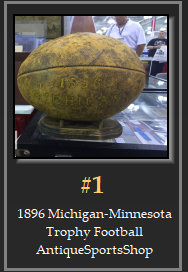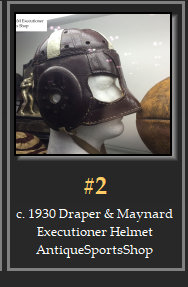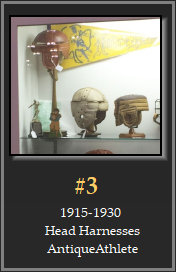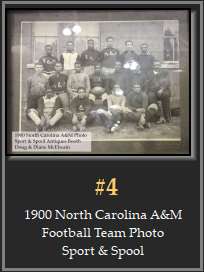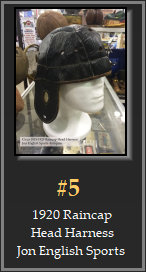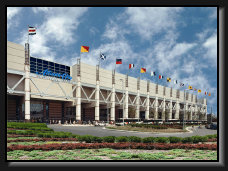
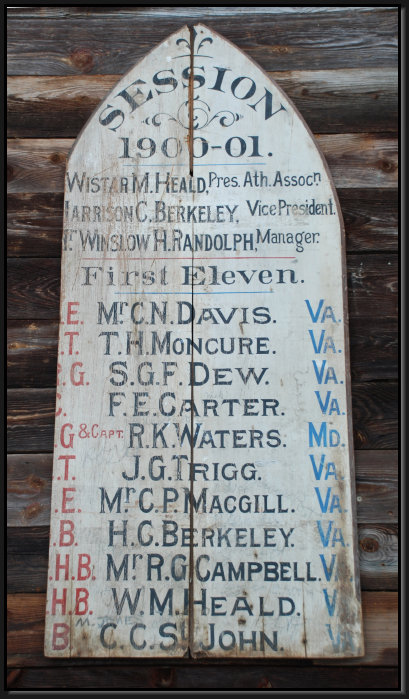
In late June, I discovered a rare football time capsule, a plaque dated 1900 that listed the names and positions of football players from a school in Virginia, my home. After a few weeks of research, I learned that uncovering and understanding the history and purpose of an artifact can be far more rewarding than its discovery.
Article from the Alexandria Gazette October 6, 1900
At nearly five feet tall, the plaque appeared to be a church directory hanging on the wall of an Adamstown, Pennsylvania antique store. Fortunately, during a quick scan my eyes settled on two words:
"First Eleven"
The reference to the starting eleven of a football squad was intriguing, but my excitement grew when I recognized the listing of football positions to the left of each name and the initials "VA" and "MD" to the right. Finding any turn of the century football artifact in Virginia is tough; finding an actual artifact with a Virginia provenance is nearly impossible, particularly in Pennsylvania. The shop owner didn't have any provenance on the piece, and a quick internet search of the names on the plaque came up empty. Despite the lack of information, the patina of the paint, the Edwardian style font, the references to Virginia, and the exciting opportunity to solve a mystery won out, and I purchased the plaque.
After several frustrating days of fruitless internet research, I received an email from Chuck of the Jones Memorial Library in Lynchburg, Virginia. Chuck discovered that one of the players on the plaque, Wistar M. Heald, attended Episcopal High School in Alexandria, Virginia in 1900.
After several frustrating days of fruitless internet research, I received an email from Chuck of the Jones Memorial Library in Lynchburg, Virginia. Chuck discovered that one of the players on the plaque, Wistar M. Heald, attended Episcopal High School in Alexandria, Virginia in 1900.
Received: Tuesday, June 30, 2015 1:00 PM
From: refdesk@jmlibrary.org
Subject: Wistar M. Heald plaque
According to the biographical obituary for Wistar Morris Heald (6 Dec 1882-28 Aug 1954), he would likely have been at Episcopal High School in Alexandria in 1900-01; he graduated from the University of Virginia, but would likely have only been a First Year student there in the 1900-01 school year, and as such, probably not President of the Athletic Ass'n. Mr. Heald was son of Charles Edward Heald & Sarah Morris Langhorne, and was President of the John H. Heald (his great-uncle's) Company, which in 1929 consolidated with Mead Corporation; he became Manager of the Heald Division of Mead., and retired in 1947. He served on the Lynchburg City Council, was President of Virginia Manufacturers' Association, Chairman of the Virginia Post-War Employment Commission, first President of the Lynchburg Rotary Club, and a Director of Peoples National Bank. He was among the organizers of Boonsboro Country Club, a member of the Elks Club, and one of the leading Episcopal Laymen of Lynchburg. You can google "episcopal high school Alexandria" for information on the school.
From: refdesk@jmlibrary.org
Subject: Wistar M. Heald plaque
According to the biographical obituary for Wistar Morris Heald (6 Dec 1882-28 Aug 1954), he would likely have been at Episcopal High School in Alexandria in 1900-01; he graduated from the University of Virginia, but would likely have only been a First Year student there in the 1900-01 school year, and as such, probably not President of the Athletic Ass'n. Mr. Heald was son of Charles Edward Heald & Sarah Morris Langhorne, and was President of the John H. Heald (his great-uncle's) Company, which in 1929 consolidated with Mead Corporation; he became Manager of the Heald Division of Mead., and retired in 1947. He served on the Lynchburg City Council, was President of Virginia Manufacturers' Association, Chairman of the Virginia Post-War Employment Commission, first President of the Lynchburg Rotary Club, and a Director of Peoples National Bank. He was among the organizers of Boonsboro Country Club, a member of the Elks Club, and one of the leading Episcopal Laymen of Lynchburg. You can google "episcopal high school Alexandria" for information on the school.
Session 1900-1901 football team roster plaque
Adding Episcopal High School to my search queries yielded a newspaper article that further linked the plaque to the school. I finally had the answer I had been searching for...but I found myself left with even more questions. What was the purpose of the plaque? Why would a school go to such lengths in 1900 to advertise its starting football team? The answers I found completely changed my understanding of turn of the century football in America.
In the early nineteenth century, the vast majority of young American males entered the workforce after completing the ninth grade at around age 16 - if they hadn't dropped out sooner. Family financial needs usually trumped the pursuit of higher education. In the days before public high schools, private secondary schools sponsored by an educator, a church or community filled the need to prepare students for college and professions in church, medicine, law, and business. Attended primarily by upper and upper middle-class students, secondary education in the nineteenth century was a privilege, available to only an estimated 5% of boys between the ages of 14 and 18. For most, a secondary education virtually guaranteed admission into a college or university.
Traditional American curricula in the mid-1800's focused on exhaustive hours of instruction and book study, which, more often than not, produced weak and pasty graduates. In 1858, Dr. Oliver Wendell Holmes, poet and professor of anatomy at Harvard wrote, "I am satisfied that such a set of blackcoated, still-jointed, soft-muscled, paste complexioned youth as we can boast in our Atlantic cities never before sprang from loins of Anglo-Saxon lineage.....Anything is better than this white-blooded degeneration to which we all tend (Holmes 1858, 881). In selecting a school, parents began to seek out schools that were committed to building their child's character as well as their mind. In response, many schools adopted a belief in "muscular Christianity," where "strength of character was intertwined with sturdiness of body," (Bundgaard 2005, 27). At first, this transformation was manifested in the lifting of prohibitions against leisure time and competitive games. In a select few however, headmasters actively encouraged, and even participated, in organized sports like cricket, baseball, track and crew.
No headmaster embraced athletics as an essential part of a young man's education more than the Reverend Endicott Peabody, founder and headmaster of the Groton School in Boston from 1884-1940. Peabody made participation in school athletics compulsory for students: "For when a boy is playing fairly, playing hard, keeping his temper, whatever the score may be, and playing for his side he is getting lessons in honestly, courage, self-control and unselfishness, and these lessons may have as much power for good upon life as the teachings of the school room," (Bundgaard 2005, 123).
Athletics in American boarding schools had several useful purposes. Increases in scholastic aptitude were observed in students that participated in athletics. For school leaders, organized athletics became a means for social control, a structured activity to replace idle time during which students might otherwise pursue nefarious activities. According to Peabody, "For moral evil you have got to consider the care of the body, and the best thing for a boy is to work hard and then, after a short interval, to play hard, and then to work hard again and then to play hard again, and then, when the end of the day has come, to be so tired that he wants to go to bed and sleep." Interscholastic competitions were also key to building school spirit and allegiance. Students rallied around their athletes and teams, and schools with successful teams attracted more students. Alumni that were enthusiastic athletics supporters could be called upon to help the school financially in times of need for the good of the school.
Despite the growing popularity of sports in secondary education, throughout the second half of the nineteenth century, intramural and interscholastic sports programs were primarily student-organized with limited oversight by school administration.
Traditional American curricula in the mid-1800's focused on exhaustive hours of instruction and book study, which, more often than not, produced weak and pasty graduates. In 1858, Dr. Oliver Wendell Holmes, poet and professor of anatomy at Harvard wrote, "I am satisfied that such a set of blackcoated, still-jointed, soft-muscled, paste complexioned youth as we can boast in our Atlantic cities never before sprang from loins of Anglo-Saxon lineage.....Anything is better than this white-blooded degeneration to which we all tend (Holmes 1858, 881). In selecting a school, parents began to seek out schools that were committed to building their child's character as well as their mind. In response, many schools adopted a belief in "muscular Christianity," where "strength of character was intertwined with sturdiness of body," (Bundgaard 2005, 27). At first, this transformation was manifested in the lifting of prohibitions against leisure time and competitive games. In a select few however, headmasters actively encouraged, and even participated, in organized sports like cricket, baseball, track and crew.
No headmaster embraced athletics as an essential part of a young man's education more than the Reverend Endicott Peabody, founder and headmaster of the Groton School in Boston from 1884-1940. Peabody made participation in school athletics compulsory for students: "For when a boy is playing fairly, playing hard, keeping his temper, whatever the score may be, and playing for his side he is getting lessons in honestly, courage, self-control and unselfishness, and these lessons may have as much power for good upon life as the teachings of the school room," (Bundgaard 2005, 123).
Athletics in American boarding schools had several useful purposes. Increases in scholastic aptitude were observed in students that participated in athletics. For school leaders, organized athletics became a means for social control, a structured activity to replace idle time during which students might otherwise pursue nefarious activities. According to Peabody, "For moral evil you have got to consider the care of the body, and the best thing for a boy is to work hard and then, after a short interval, to play hard, and then to work hard again and then to play hard again, and then, when the end of the day has come, to be so tired that he wants to go to bed and sleep." Interscholastic competitions were also key to building school spirit and allegiance. Students rallied around their athletes and teams, and schools with successful teams attracted more students. Alumni that were enthusiastic athletics supporters could be called upon to help the school financially in times of need for the good of the school.
Despite the growing popularity of sports in secondary education, throughout the second half of the nineteenth century, intramural and interscholastic sports programs were primarily student-organized with limited oversight by school administration.
The Rise of Athletics in American Boarding Schools
Founded in 1839, Episcopal High School is the 42nd oldest boarding school in the U.S. and the oldest high school in Virginia. Located in Alexandria, Virginia, minutes from Washington, D.C., Episcopal High School was actually the only high school in Virginia for the first 30 years of its existence. An initial enrollment of 35 students soon grew to over 100 shortly before the Civil War, during which the school was closed and occupied by Federal troops. Many of its students and alumni left to fight in the war, overwhelmingly in support of Virginia and the Confederacy. Episcopal reopened in 1866, and in what was perhaps one of the most significant events in the school's history, hired Launcelot Blackford as principal in 1870.
Episcopal High School


1882 Episcopal High School Football Team, Episcopal High School Athletics Database, photo courtesy of Episcopal High School, http://www.episcopalhof.com/
Portrait of Launcelot Blackford, Principal, Episcopal High School, photo courtesy of Episcopal High School
Born in 1837 in Fredericksburg, Virginia, Launcelot Blackford's family personifies the moral conflict many Virginians had with slavery in the early nineteenth century. Launcelot's ancestors, the Carters, Minors, and Blackford's were slaveholding plantation owners in Virginia. Remarkably, despite owning slaves themselves, Blackford's parents William Blackford and Mary Berkeley Minor were outspoken advocates for the abolition of slavery and the recolonization of emancipated slaves in Africa. In 1832, Mary Berkeley Minor Blackford authored a journal entitled "Notes illustrative of the wrongs of slavery." In 1954, Launcelot Blackford's son, Launcelot Jr., wrote "Mine Eyes Have Seen the Glory: The Story of a Virginia Lady Mary Berkeley Minor Blackford 1802-1896 Who Taught Her Sons to Hate Slavery and to Love the Union." Most remarkable of all, despite their anti-slavery sentiments and their love for the "Union," Launcelot Blackford and his four brothers all chose to defend their state in the Civil War and fought for the Confederacy.
As headmaster, Blackford believed in a familial school environment and was an ardent supporter of intramural and interscholastic athletics. In the late 1800's, school athletics were primarily limited to student run activities during leisure time. Seeking to encourage more organized play, in 1878 Blackford purchased the school's first rugby ball and football rule book for the students.
A Civil War veteran who had experienced the horrors of war, Blackford may also have been motivated by the belief that "young men could learn the hard lessons of war and develop tough moral character through a battle on the playing field without the actual bloodshed and death of armed conflict (Fredrickson, 1965, 218-25)."
As headmaster, Blackford believed in a familial school environment and was an ardent supporter of intramural and interscholastic athletics. In the late 1800's, school athletics were primarily limited to student run activities during leisure time. Seeking to encourage more organized play, in 1878 Blackford purchased the school's first rugby ball and football rule book for the students.
A Civil War veteran who had experienced the horrors of war, Blackford may also have been motivated by the belief that "young men could learn the hard lessons of war and develop tough moral character through a battle on the playing field without the actual bloodshed and death of armed conflict (Fredrickson, 1965, 218-25)."
Launcelot Minor Blackford
The earliest record of an official football team at EHS was in 1882, making it one of the first football programs in Virginia. In comparison, the University of Virginia first fielded a team in 1888, and Virginia Agricultural and Mechanical College (Virginia Tech) followed in 1892. In fact, Yale University, one of the oldest football schools in the U.S., first fielded a team only ten years prior in 1872.
In an incredible stroke of luck, the date of the plaque coincided with the recording of the 1900 United States Census. On June 22, 1900, the census bureau "enumerated" Episcopal High School, recording Launcelot Blackford as the head of household for his family and 73 male "pupils" between the ages of 14 and 20. Six of the nine football players on the plaque appeared in the two page census record, which revealed that EHS's students hailed from 17 different states.
Episcopal High School in 1900


June 22, 1900 U.S. Census, Episcopal High School, pg 1.
June 22, 1900 U.S. Census, Episcopal High School, pg 2.
The Discovery
Football Time Capsule

The U.S. Census officials must have been impressed with EHS and its football program, for Episcopal High School's first opponent in their 1900 season was....the census bureau team of Washington.
A 115 Year Old Relic and its Place in Football History
Chris Hornung
July 23, 2015
Chris Hornung
July 23, 2015
